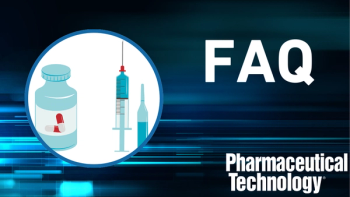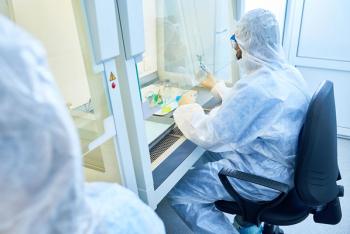
- Pharmaceutical Technology-03-02-2012
- Volume 36
- Issue 3
Genotoxic Impurities: A Q&A with Amgen's Bo Shen
Genotoxic impurities and how to identify them and control for them have been a concern for several years in the pharmaceutical manufacturing industry. Pharmaceutical Technology spoke with Bo Shen, PhD, principal scientist at Amgen and chair of the AAPS Pharmaceutical Trace Impurities Focus Group, to gain insight on key challenges.
Genotoxic impurities and how to identify them and control for them have been a concern for several years in the pharmaceutical manufacturing industry. In recent years, FDA has issued draft guidance on the subject, EMA has issued final guidance, and the International Conference on Harmonization (ICH) is putting together a related M7 guideline to complement its Q3A and Q3B guidelines on impurities (1–3). Still, challenges remain. Pharmaceutical Technology spoke with Bo Shen, PhD, principal scientist at Amgen and chair of the American Association of Pharmaceutical Scientists (AAPS) Pharmaceutical Trace Impurities Focus Group, to gain insight on these challenges.
Key challenges and regulatory requirements
PharmTech: What would you say are the key challenges facing drug manufacturers today regarding genotoxic impurities (GTIs)? Is there still concern over FDA and EMA requirements/threshold limits or approaches for controlling for these impurities?
Shen: The identification of GTIs in pharmaceutical products, assessment of a safe level of exposure to these impurities, and establishing the corresponding limits are the key challenges and concerns still facing drug manufacturers.
Drug manufacturers have to identify GTIs early in process development, develop analytical methods, and demonstrate a control strategy to ensure patient safety. The assessment/identification phase involves a process by which the synthetic pathway is evaluated and through a combination of chemical reasoning and analytical testing, either known or potential genotoxic impurities (pGTIs) may be identified.
To assess pGTIs, drug manufacturers use a combination of in-silico tools, evaluate scientific literature and public databases, and may conduct an Ames test to determine the mutagenic potential of chemical compounds. The result of an Ames test takes precedent over the predictions made by in-silico programs. Of the in vitro genotoxicity tests, the Ames test is the most reliable predictor of carcinogencity. Therefore, a compound that is positive in the Ames test is classified as genotoxic unless a substantial weight-of- evidence exists to conclude that the compound does not represent a genotoxic risk to patients.
To build such weight-of evidence involves conducting additional in vitro and in vivo gentoxicity tests that require significant resources and can lead to program delays if the GTIs cannot be controlled to the threshold of toxicological concern (TTC) while additional studies are being conducted.
Another challenge is that the Ames test may not be sensitive enough to detect GTIs when the impurity is assessed by testing the drug substance. The detection limit for many mutagens in the Ames test is 250 µg/plate, which represents a level far higher than is typically encountered for impurities in drug substances. Therefore, in many circumstances, the isolated impurity needs to be tested instead. Synthesis of an impurity in amounts and purity sufficient for Ames testing can provide a challenge to drug manufacturers.
After identifying GTIs, to ensure patient safety, drug manufacturers have to establish a robust control strategy to prevent or limit GTIs in the final API. Control strategy approaches will vary by companies. Some companies may choose to alter synthetic routes to avoid using or generating GTIs altogether; whereas, other companies may consider this impractical, especially when multiple GTIs must be handled and making changes might only lead to new ones.
The need of controlling several GTIs at the TTC level during analytical and process development further complicates the control strategy. Structural considerations can be complicated and numerous challenges can exist.
With the regulatory guidance in this area evolving and the need to ensure drug product quality and patient safety, drug manufacturers are faced with the challenge of effectively establishing and implementing robust internal practices which balance time, cost, and risk.
Analytical approaches
PharmTech: From an analytical-chemistry perspective, to meet current requirements regarding genotoxic impurities, how does it change the level, extent, or type of analytical testing that needs to be performed for an analysis of a particular active ingredient or finished drug product? Is typical impurity testing sufficient, or what additional testing or approaches may be required?
Shen: Consider the GTI control requirements, taking into account the TTC limit (1.5 µg/person/day) and the corresponding levels of the GTI in the drug substance, it can be calculated that for a daily dose of 1 g/person the limit for the GTI is 1.5 ppm and for a daily dose of 100 mg/person the corresponding limit is 15 ppm. This translates into target limits for GTI detection and quantification at levels of about 1 ppm, that is almost 500 times lower than those for classical impurity analysis (1 ppm versus 0.05%). Typical impurity testing is not suitable for GTI determination since their quantitation limit is generally 500 ppm (0.05%). Assessing multiple impurities in the low ppm range can be a significant analytical problem and challenge.
Liquid chromatography (LC) with ultraviolet (UV) detection and gas chromatography (GC) with flame ionization detection are often adequate for the impurities at 100 ppm level. In the range of 1–10 ppm or lower, hyphenated mass spectrometry (MS) techniques such as LC–MS and GC–MS are by far the most appropriate techniques. These techniques, due to sensitivity and selectivity, have been widely used in GTI analysis.
In addition to sensitivity and specificity, other challenges in GTI analysis may include:
- Sample matrix interferences: techniques such as pre/post-treatment derivatization may be used to overcome these challenges.
- Analytes which are chemically reactive or unstable: special handling techniques may be required to overcome low recover or poor sensitivity.
- Analytes which are not suitable for common analytical detectors.
PharmTech: One of the FDA draft guidance recommendations on GTIs involves changing the synthetic or purification route to reduce or remove the impurity (1). Has this—or will this—become a challenge for drug manufacturers, particularly, if the synthesis of API involves intermediates or raw materials not internally produced and if these are be considered a source of the resulting impurity? If so, how is that addressed?
Shen: Changing synthetic routes or using purification could effectively avoid generating GTIs during the synthesis. However, route selection takes into account both yields and manufacturability considerations. Because of their intrinsic high reactivity, reactants and intermediates used in manufacturing processes may be genotoxic substances and it may not be suitable to avoid their use.
When changing synthetic routes is not feasible, pGTIs and GTIs are identified by a careful analysis of both the degradation products and the manufacturing process, taking into account reagents, intermediates and by-products. When the presence of a GTI is established, an explanation why no alternative to the use/formation of this impurity is possible (including alternate synthetic routes) should be provided as part of the pharmaceutical assessment. The technical effort aimed at reducing the GTI level according to ALARP, or as low as reasonably practical, should be documented. This latter part of the pharmaceutical assessment could give rise to some practical applicability issues.
For the intermediates or raw materials not internally produced, most companies are conducting rigorous testing to control impurities, or even establish specifications.
Industy's perpsepctive
PharmTech: What has been the role of the AAPS Pharmaceutical Trace Impurities Focus Group for genotoxic impurities on this issue?
Shen: The focus group provides benefits to pharmaceutical scientists by providing a single, broad forum to discuss technical and regulatory topics associated with the impurities, and to better understand at the grassroots level the practices, approaches, and trends used across the industry. Since its inception in 2010, the group has played an influential role on promoting scientific discussion for control and test strategy of genotoxic impurities. In the next few years, the group will continue to focus on highly sensitive analytical methodology development, process development, and genotoxicity tests for impurities/genotoxic impurities that are capable of controlling these impurities.
The group will effectively communicate to establish dialogues among industry, academia, and regulatory groups to discuss technical advances, and understand and apply changes in regulatory viewpoint on impurities/genotoxic impurities. The group will aim to facilitate discussion around science/risk-based regulations and regulatory review practice, and will work to catalyze opportunities to expand targeted academic support and collaborations on topics involving impurities/genotoxic impurities. Overall, the focus group offers a forum for discussion among researchers engaged in basic scientific work in analytical and process chemistry as well as toxicology, and serves as an outlet to connect with members of other sections and focus groups with related interests in the field.
The focus group routinely develops programming proposals in collaboration with other focus groups, such as the AAPS API Focus Group and other industry stakeholders, including the ICH M7 expert working group. For example, the focus group published the first industrial survey results about GTI and is in preparation and conducting a second industry survey on the methodology of the control of the GTIs. The AAPS focus group also organizes educational webinars and events.
These activities reflect the goals of the AAPS focus group, which include to:
- Establish a core group of interested scientists to explore diverse areas of genotoxic impurities and discuss technical and regulatory issues pertinent to genotoxic impurities
- Define technical and regulatory genotoxic impurities issues related to development of pharmaceuticals
- Provide a forum to discuss genotoxic impurities scientific issues and exchange ideas/best practices
- Organize quality programs for the annual meeting and to conduct workshops on current ICH and FDA and international requirements
- Provide an avenue for training of new guidance on impurities/genotoxic impurities topics
- Act as a link among members of industry, academia, and regulators
- Facilitate workshops/symposia and thereby share experiences and communicate key lessons learned with industry and regulators.
We welcome scientists and regulators to participate in the activities organized by the AAPS Pharmaceutical Trace Impurities Focus Group.
Acknowledgments
Bo Shen would like to specially thank Dr. Kurt Black, Dr. Ruth Lightfoot–Dunn, Dr. Jerry Murry, Dr. David Semin, and Dr. Sophie Wang for their review and input on this Q&A.
References
1. FDA, Draft Guidance for Industry: Genotoxic and Carcinogenic Impurities in Drug Substances and Products: Recommended Approaches (Rockville, MD 2008).
2. EMA, Guideline on the Limits of Genotoxic Impurities (2006).
3. ICH, M7 Assessment and Control of DNA Reactive (Mutagenic) Impurities in Pharmaceuticals to Limit Potential Carcinogenic Risk, Concept Paper (2009).
Articles in this issue
almost 14 years ago
Pharmaceutical Technology, March 2012 Issue (PDF)almost 14 years ago
Platform Technologiesalmost 14 years ago
Tackling Solubility Challengesalmost 14 years ago
Total Recallalmost 14 years ago
Securing the Pharma Supply Chainalmost 14 years ago
Defining Conflict of Interestalmost 14 years ago
Report from Brazil March 2012almost 14 years ago
Inside USP: A Holistic Approach to Supply-Chain Integrityalmost 14 years ago
Evaluating Impurities in Drugs (Part II of III)Newsletter
Get the essential updates shaping the future of pharma manufacturing and compliance—subscribe today to Pharmaceutical Technology and never miss a breakthrough.





